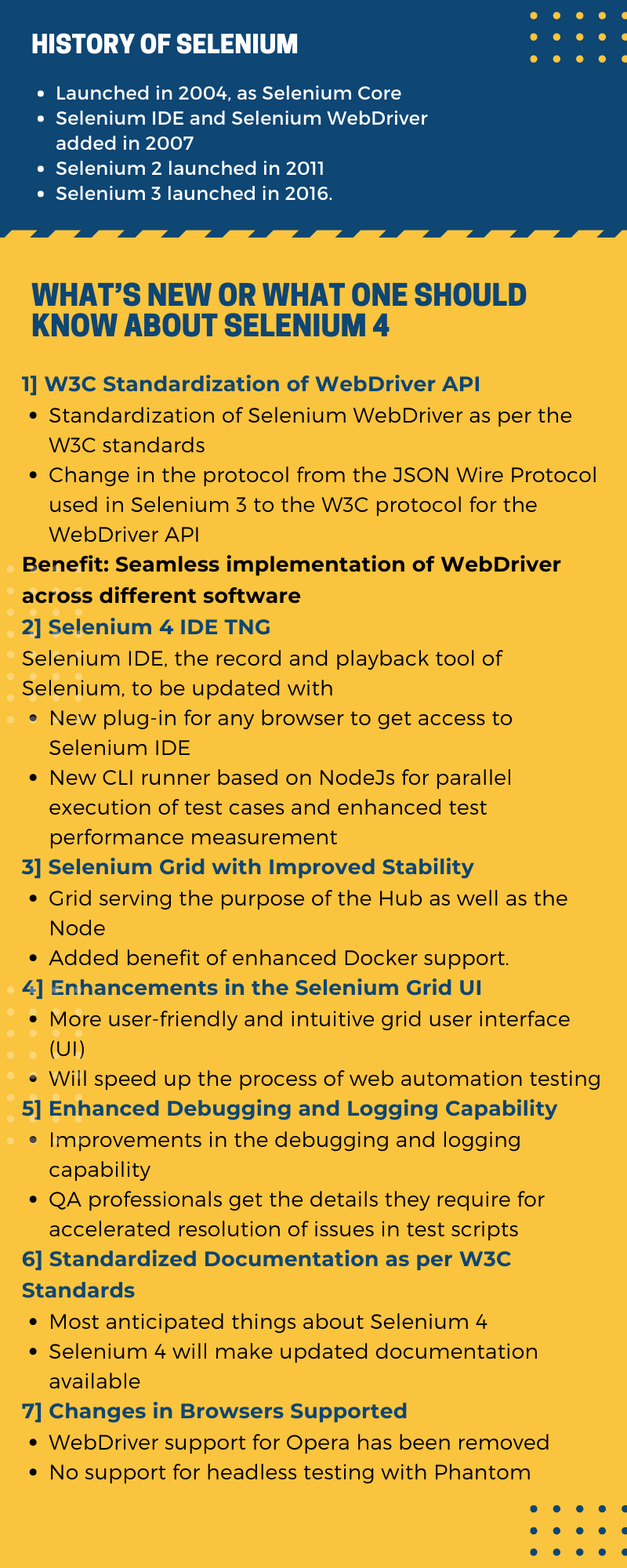What You Need to Know about the Selenium 4 Alpha (Infographic)

Selenium is a test automation framework that needs no introduction. It is the most popular test automation tool used by QA professionals alike. Launched in 2004, as Selenium Core, it is an open source framework which had its two components – Selenium IDE and Selenium WebDriver – added to it in 2007. Then it was in 2011 that Selenium 2 was launched, followed by Selenium 3 in 2016. Selenium is also a popular test automation framework used in leading new age test case management tools and QARA Enterprise is an example. QARA Enterprise is a zero coding test automation tool that is built on Selenium for improved web application testing.
QA professionals all over the world are awaiting the release of Selenium 4, after the Selenium 4 Alpha was released on 29th April 2019. As the release date of Selenium 4 knocks at the door (the speculated release date is in Oct 2019), it’s time to look back and take another look at all things new in Selenium 4 Alpha, just to know what to expect when Selenium 4 is finally launched.

One of the many things that are new in the soon-to-be-launched Selenium 4 is the change in the protocol from the JSON Wire Protocol used in Selenium 3 to the W3C protocol for the WebDriver API. This is a major change involving the standardization of Selenium WebDriver as per the W3C standards. This change implies that the communication will no longer require encoding and decoding of API requests. Since WebDriver is used by other tools and products as well, including Appium and iOS Driver, this move will ensure seamless implementation of WebDriver across different software.
The Selenium IDE, the record and playback tool of Selenium, will witness major enhancements and will be updated with the following advanced and richer features:
- New Plug-in System: As we know, earlier, the Selenium IDE was designed to be used only on Google Chrome browser only. However, the introduction of a new plug-in will make it possible for any browser to get access to Selenium IDE. Users can have their own locator strategy and plug-in.
- New CLI Runner: In addition to the plug-in for supporting other browsers, a new CLI runner is also expected to be a part of the Selenium 4. Unlike the old runner that was based on HTML, this one will be based on NodeJs. The improved runner will display WebDriver playback, and will be based entirely on the WebDriver. Also, this new CLI runner will provide support parallel execution of test cases and also provide the QA team with key information to determine the performance of the test execution process.
3] Selenium Grid with Improved Stability
One of the new things that Selenium 4 will offer is a Selenium Grid with improved stability. One of the challenges of using the Selenium Grid has been the difficulty in set up and configuration, with issues like connecting nodes and hubs. However, the Selenium 4 will resolve this issue with a configuration that will make the grid serving the purpose of the Hub as well as the Node. There is also the added benefit of enhanced Docker support.
Another enhancement that you can expect from the Selenium 4 is a more user-friendly and intuitive user interface (UI) of the grid, offering relevant and key information about the test case execution capacity as well as the details about test executions, and more. This will speed up the process of web automation testing.
Improvements in the debugging and logging capability is another change that is expected in Selenium 4. To be specific, Selenium 4 will provide QA professionals the details they required for accelerated resolution of issues in test scripts for web test automation.
6] Standardized Documentation as per W3C Standards
We all know that documentation is one of the key requirements for any platform, and Selenium is no exception. Since the test automation framework hasn’t been updated since Selenium 2.0 was released in 2011, there was a urgent need for refreshing the documentation. However, this is going to change with the availability of updated documentation with Selenium 4. This is one of the most anticipated things about Selenium 4, as the entire QA community is looking forward to it.7] Changes in Browsers Supported
While the Selenium IDE is all set to offer a plug-in for other browsers in Selenium 4, the WebDriver support for Opera has been removed. It is recommended that Opera users use Chrome instead. Also, there is no support for headless testing with Phantom, and it is recommended to use Firefox and Chrome instead.Conclusion:
So, we see that there is a lot to expect from the Selenium 4, be it the browsers supported, the documentation, as well as the UI, among others. In fact, the changes will surely be a game changer in the world of web test automation. Want to experience enhanced web test automation with Selenium through a zero coding framework, just request a Trial of QARA Enterprise, which is a zero coding test automation tool based on Selenium.
Write a comment
- Diksha Kakade January 13, 2020, 11:35 amThank you for such an amazing blog for Selenium 4 alpha infographic. I am also in the Technical field. It would really help me.reply
